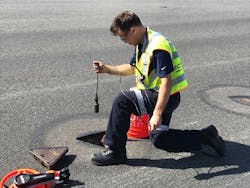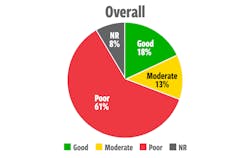Many water utilities across North America are struggling with budgeting and managing the required renewal plans of their aging buried water assets that have reached the end of their service life. Spending time and money on assessing the condition of this buried infrastructure before breaking ground is proving to be the most prudent spend.
The City of Detroit Water and Sewerage Department (DWSD) developed a holistic approach to optimize the assessment of their most vulnerable watermains. DWSD and AECOM performed an initial desktop assessment, to prioritize the City’s water main renewal program based on risk. This initial assessment was primarily focused on water main failure/break history coupled with additional parameters such as hydraulic capacity, criticality, and surrounding parallel asset infrastructure renewal efforts to characterize consequence of failure, likelihood of failure and rehabilitation opportunity.
The desktop assessment model allowed DWSD to identify critical mains and prioritize mains where evidence-based condition assessment was needed. 31 miles of cast and ductile iron water mains in various neighbourhoods within the City of Detroit were prioritized for condition assessment using Echologics® ePulse® condition assessment technology from Mueller.
An Echologics field team was brought on site to use ePulse technology to assess the structural integrity of the pipes without breaking ground or any disruption to the service. This technology can measure the average minimum remaining wall thickness of ductile and cast-iron cast iron, and the minimum average remaining wall thickness of asbestos cement and concrete water pipes over a measured segment (generally between 250 to 650 ft).
In total, 348 pipe segments with an average length of 478 ft were assessed for the minimum remaining minimum structural wall thickness and were then compared to the original nominal wall thickness to determine the average structural wall loss. Results were categorized by condition into good (< 10% degradation), moderate (10-30% degradation) or poor (>30% degradation).
Figure 1 shows the results breakdown by condition category for the entire project scope. The pie chart shows that the majority, 61% of pipe tested, was identified to be in poor condition, while 18% was identified to be in good condition and 13% in moderate condition.
Anil Gosine, Program Manager of the City of Detroit Water and Sewerage Department said, “We were pleased that both the desktop modelling and ePulse assessment did not require any excavating, external traffic control or interruption to the water service.” By identifying and subsequently validating through the ePulse assessment the most critical 19.3 miles of pipe, the department can now confidently proceed with allocating budget and replacing these sections based on sound data.
During the testing for condition assessment, they also identified 14 leaks, an added benefit of using ePulse. DWSD has also now deployed EchoShore®-DX leak permanent monitoring system in other parts of their water distribution system. This technology incorporates the latest generation of acoustic sensors capable of identifying extremely faint acoustical noises emitted by leaks before they become detectable by conventional methods.
Editor's Note: Scranton Gillette Communications and the SGC Water Group are not liable for the accuracy, efficacy and validity of the claims made in this piece. The views expressed in this content do not reflect the position of the editorial teams of Water & Wastes Digest, Water Quality Products and Storm Water Solutions.

